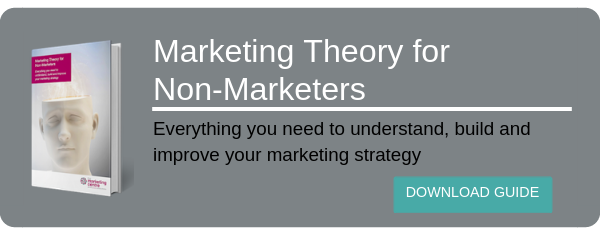
Financial services have changed drastically in the last thirty years. The sector has seen an ongoing drift from no regulation to voluntary regulation, and then to compulsory regulation governed by the Financial Conduct Authority.
Prior to 2008 – with a few exceptions including First Direct, NFU and Egg – financial services companies received poor reviews from customers. The 2008 crisis exacerbated this problem, with banks going from trusted institutions to devious fat cats, and the challenge of marketing in the financial sector has only grown as consumers become more savvy.
Besides his work with The Marketing Centre, Mark Pearson has consulted for RBS, Zurich, Equiniti and HMRC. He has three decades’ experience marketing for fintech and financial services - in that time he’s launched three banks, brought two brands to market leadership, and was among the founding members of Egg, the world’s first Internet-only bank.
Who better to guide us around today’s financial services scene, and how to market effectively within it?
TMC: What was financial services marketing like when you started out - and why do you think it’s changed?
Mark Pearson: The sector’s far more regulated than it used to be, which reflects the responsibility of financial service firms to market and design propositions aimed at their customers. If you look at the issues regulation addresses - things like PPI - they’re all about poorly designed or inadequately explained products being sold to the wrong people.
This is a classic case of financial institutions putting money before the customers. Now, they’re coming round to the idea that customer-first is everything. It’s something I tried to promote way back when I was with the Prudential as a product manager. I would go out and visit customers with the sales staff, and see how people treated our product and what their financial needs were. Much of the Pru’s business included going door-to-door and talking to customers about their circumstances. It wasn’t uncommon for our salesperson to ask to see the client’s policy or collection book on a visit, and they’d say “Oh, I think it’s around somewhere, I knew we were going to review our policy,” and they’d find it on the iron or in a cupboard somewhere. This puts your product’s importance in the customer’s life into perspective.
- You may like: Marketing Theory for Non-Marketers
Move forward 20+ years and we live in a more diverse society, though most of us are familiar with technology like mobile apps and contactless payments. Today, financial services firms have to contend with legacy systems, or are guilty of implementing new technologies with little thought as to whether they meet the need of their customer. You have to understand what your customers are saying and doing - if you don’t, you’re setting yourself up to fail.
TMC: How did you put that customer understanding to work in-house?
Mark: If customers are at the heart of your business, the research and insight team has to be actually out there on the front line driving and guiding the business, monitoring customer experience and identifying the needs. At Egg, I moved the insight team into customer services, putting insight at the coalface and giving customers a role at the heart of operations.
Tactically, we started running online surveys very early on - we got about a 60% response rate, which was fantastic for us - and we could use those to monitor performance. If a customer gave us one or two out of ten for satisfaction, we gave their response to customer relations, who’d do an outbound call and ask, “How can we help?” That changed their perspective and brought them back on board. After all, when was the last time you were phoned by a business you’d rated poorly earlier that day? The result was market-leading customer satisfaction rates and high levels of recommendation.
It also meant I could recognise and ignore the bad advice. We’d been working with a branding agency who told us “Egg is such a powerful brand, you don’t need to worry about a corporate colour” - which was off, because the customers had green credit cards, and as far as they were concerned, Egg’s brand colour was green.
As a result, I took the opportunity to rebrand Egg back to green, aligning this shift with the brand repositioning itself as an innovator launching an innovative credit-come-savings card and a new mobile app service, in partnership with O2. The result was to take Egg to market leader once more.
TMC: Talking of product development: you were basically in the lead on Internet banking. What was that like at the start?
Mark: Originally, nobody thought anyone would use online, but we went out with some market-leading rates, everyone wanted those, and the call centre phones were suddenly on fire, so we left only our online channel open and continued to be flooded with new customers.
A lot of companies use technology for its own sake: they don’t make it useful for the customer. We offered something valuable and that drew customers into using the tech.
The big banks are leaning into mobile-based banking now, appealing to a younger audience, but they have to balance that against their older customers who still want to go to a branch, pay in cash and write cheques. They can’t close the branches yet, but from a cost perspective they have to shift over - that’s why you’re seeing things like the kioskless, cashierless branches. You need to have really good segmentation in banking and either appeal across these areas, or start focusing on only a few of them.
TMC: What about the investor side of financial services?
Mark: There’s a lot of big data being used - so if you’re looking to make good investment choices, you can bring in all sorts of environmental trends and predictions. You can find out that there’s slow-moving drought in a country so crops aren’t going to be great; or you could see that there’s been flash flooding in Australia that’s taken a load of mines out.
With big data, customers can be presented with information in realtime to make informed choices about what and when they invest in or sell.
TMC: So, we have this tech-enabled financial services market: what kind of marketing mistakes do companies make in them?
Mark: The first one is too much emphasis on price. If you get someone in on a cheap price and you’re not offering value, you end up recycling customers continuously - which is expensive. Unless you give extraordinary customer service, you find most of the bargain hunters just leave. If you’re offering a cash ISA you can’t just chase rates - you have to offer an incentive. At Selftrade, we offered a free Kindle if you saved £5000 over a year, and a loyalty bonus for keeping the account after that - there was an incentive to join and an incentive to stay.
The next is seeing regulations as a problem. Often, companies think “how can we get around the rules?” or “how do we avoid being fined?” If you’re trying to sell the right product to the right audience there isn’t an issue. GDPR is pushing towards that customer-first attitude anyway, so it’s best to adopt that mindset ASAP.
Number three is not starting with insight. You can source it from all sorts of places - your own customer database, big data, primary or secondary customer research. If you run primary insight, you have to design the product to test and not rely on the customer to design it. If you say to someone “can you design me a new credit card?” and you don’t have the data on what people want it to look like, they won’t have a clue and you won’t get what you need.
Number four is going for the shiny toys. If you’re lunging for the latest new technology and you haven’t thought about demands and incentives, you’re going to fail. This applies to demographics, too: I work with a lot of people who don’t segment properly. They say “we’re going for Millennials”, as though everyone in their twenties is identical. You need to look into behavioural segmentation, and attitudes to tech within those segments. That tells you what technology people are prepared to use, and you can design from there.
And five is not building a meaningful relationship to make customers stay with you for longer. In the early days you can afford to treat them generically, but as the journey goes on, you should learn more about that person, and tailor more to them. You need to build a proposition that’s more than an initial one-day offering: you need to understand the whole customer journey, how all the touchpoints operate. Map things out in those terms and you see where the gaps are: then you can improve on them.
Financial services have changed a lot since telephone banking was a novelty, and the traditional banking sector can’t rely on the brand equity it used to have. By putting customers first and building substantial relationships with them, using tech and data in support, financial institutions can put their marketing back on the money.
Thanks to Mark for his time, and his insight. To learn more about those marketing mistakes - and how to avoid them - read up on marketing theory for non-marketers. If you’re ready to put your own marketing back on the money, get in touch with us today.
Featured image:
By 0x010C [CC BY-SA 4.0], from Wikimedia Commons




